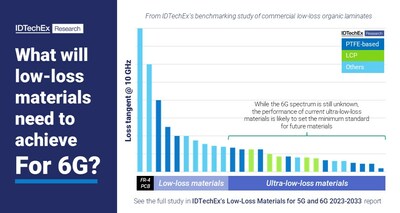BOSTON, Feb. 17, 2023 /PRNewswire/ -- The next generation of telecoms technologies, 5G, is not fully deployed yet; in fact, the exciting high-frequency bands of mmWave 5G are not set to take off for another several years, according to IDTechEx forecasts. Still, people are already considering the next-next generation of telecommunications - 6G. While 5G will enable society to control more devices remotely in applications where real-time network performance is critical, 6G will bring much richer connectivity to the physical world, using advancements in AI and computing to enhance the machine-human interface. So, although 6G spectrum will not be standardized till 2027 at the earliest, researchers and OEMs like Huawei are already exploring the technical advancements needed to facilitate 6G.

Low-Loss Materials: The Essential Building Block for 6G
As with any new technology, material innovations act as essential building blocks on which other technical advances can develop. This is no different with 6G. While transmission loss and atmospheric dispersion is bad enough at high frequency 5G bands, affecting the range and signal integrity of mmWave 5G networks, it will be even worse at 6G bands like the D-band (110-170GHz). Thus, the world's 1st consortium for 6G technology development, 6Genesis Flagship Program 2018, identified the development of new low-loss materials as a critical technology enabler for 6G. Therefore, it is important to investigate the potential dielectric performance required for 6G technologies, which is spurring current research into ultra-low-loss materials for 6G by many important players.
The key players developing in this field include materials suppliers like Taiyo Ink and ITEQ Corporation and research institutions like the USA'sGeorgia Institute of Technology, South Korea'sYonsei University, and Germany's Fraunhofer IKTS (Institute for Ceramic Technologies and Systems). Some approaches for low-loss materials for 6G involve commercially established materials like PTFE, PPE, and glass fiber-reinforced thermosets with novel architectures or molecular compositions. Other approaches involve less conventional materials, like low-cost thermoplastics, silica foams, or even wood-based composites.
The development of these dielectrics is challenging on many levels. First, there is no clear dielectric performance target for these materials to hit. IDTechEx expects the loss tangents of current commercial ultra-low-loss laminates to be the minimum performance standard for 6G devices, and it is difficult now to see how much lower loss tangents will need to be for 6G devices.
It is also tricky to even characterize dielectric materials at terahertz frequencies, which iNEMI (the International Electronics Manufacturing Initiative) is researching with their 5G/6G MAESTRO project. Lastly, none of this considers the cost and manufacturability of such ultra-low-loss materials, which will significantly affect the economic viability of 6G devices. Suffice to say, there is a lot of work to be done to advance low-loss materials enough to support 6G communication networks.
What Low-Loss Materials Can Enable: Reconfigurable Intelligent Surfaces (RIS)
With the right innovations, low-loss materials will support some critical 6G technologies, like reconfigurable intelligent surfaces (RIS) made of metamaterials. Metamaterials are structures consisting of a periodic regular pattern that is designed to interact with an incident wave; RIS are artificial surfaces that can produce unique wireless communication capabilities. RIS integrates passive or active metasurfaces to redirect and (occasionally) amplify telecommunication signals. The primary factor distinguishing RIS from existing technology are their cheap, almost passive panel of unit cells; these have reflective functionality when entirely passive but can steer/amplify the beam if active. RIS can be used in many 6G wireless telecommunications applications, from beam amplification at base stations to active direction of signals to users. Not only can RIS enhance signal quality and coverage, but they also offer other benefits like reduced energy consumption and increased security compared to existing steering technologies. There is a tradeoff to be made, but the use of more RIS can enable fewer base stations for the same coverage, lowering costs for the same network coverage.
Critical to RIS are low-loss radio frequency metamaterials. With operating frequencies between 95GHz and 1THz, minimizing transmission loss from metasurfaces is essential to maximizing their performance for RIS. Current research and development in low-loss materials for 6G are integral to implementing not only RIS but other impactful 6G applications.
Market Forecasts for Low-Loss Materials for 5G and 6G
IDTechEx's report, "Low-loss Materials for 5G and 6G 2023-2033", explores these technology and market trends driving low-loss materials for next-gen telecommunications like 6G. IDTechEx forecasts future revenue and area demand for low-loss materials for 5G while carefully segmenting the market by frequency (sub-6 GHz vs. mmWave), six material types, and three application areas (smartphones, infrastructure, and CPEs) to provide sixty different forecast lines. For further information on low-loss materials for 5G and 6G, including material benchmarking studies, player analysis, market drivers and barriers, and granular 10-year market forecasts, please visit www.IDTechEx.com/LowLossMats.
For the full portfolio of 5G/6G related research available from IDTechEx, please visit www.IDTechEx.com/Research/5G.
About IDTechEx
IDTechEx guides your strategic business decisions through its Research, Subscription and Consultancy products, helping you profit from emerging technologies. For more information, contact research@IDTechEx.com or visit www.IDTechEx.com.
Images Download:
https://www.dropbox.com/scl/fo/5q7dlhkxy6aagurcl6z9n/h?dl=0&rlkey=q45isfcmfxh8b6gt256n7we38
Media Contact:
Lucy Rogers
Sales and Marketing Administrator
press@IDTechEx.com
+44(0)1223 812300
Social Media Links:
Twitter: www.twitter.com/IDTechEx
LinkedIn: www.linkedin.com/company/IDTechEx
Facebook: www.facebook.com/IDTechExResearch

Photo: https://mma.prnewswire.com/media/2004981/IDTechEx_LLM_6G.jpg
Logo: https://mma.prnewswire.com/media/478371/IDTechEx_Logo.jpg
![]() View original content:https://www.prnewswire.co.uk/news-releases/low-loss-materials-for-6g-idtechex-discusses-the-current-status-and-future-direction-301749710.html
View original content:https://www.prnewswire.co.uk/news-releases/low-loss-materials-for-6g-idtechex-discusses-the-current-status-and-future-direction-301749710.html
